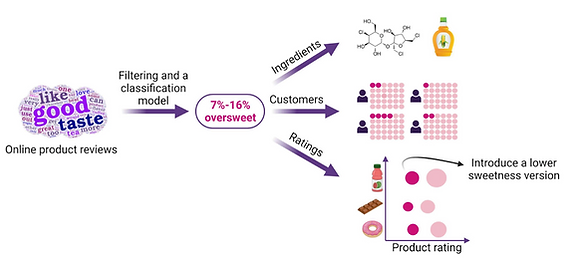Research
We combine cheminformatics, molecular dynamics, machine learning, and AI with cell-based, structural, and human sensory studies to unravel the mysteries of taste perception and to explore the roles of taste GPCRs in both oral and extraoral physiology

The bitter chemical space
What makes a molecule taste bitter? We study the chemical space of bitterness - its molecular determinants, sensory consequences, and evolutionary significance.
We maintain BitterDB, https://bitterdb.agri.huji.ac.il/ database of bitter compounds. To understand and predict bitterness, we develop and apply machine learning models and large language models (LLMs) that integrate chemical, structural, and phylogenetic data.
Recent tools and resources include:
-
BitterDB: 2024 update on bitter ligands and taste receptors, Nucleic Acids Research, 2024, doi: 10.1093/nar/gkae1044
-
BitterPredict, a tool for predicting taste from chemical structure https://www.nature.com/articles/s41598-017-12359-7
-
BitterIntense: Intense bitterness of molecules: Machine learning for expediting drug discovery https://doi.org/10.1016/j.csbj.2020.12.030
-
BitterMatch: recommendation systems for matching molecules with bitter taste receptors https://doi.org/10.1186/s13321-022-00612-9
-
BitterMasS: Predicting Bitterness from Mass Spectra, Journal of Agricultural and Food Chemistry https://doi.org/10.1021/acs.jafc.3c09767
-
These tools enabled us to challenge the “Bitterness signals toxicity” paradigm https://doi.org/10.1002/iub.1694 and to identify connections about stinky smell and bitter taste https://doi.org/10.1021/acs.jafc.3c00592 .



Bitter taste receptors
Bitter taste receptors (TAS2Rs) belong to the GPCR family and are remarkable for their ability to recognize a vast array of structurally unrelated molecules - from secondary plant metabolites to synthetic drugs. The number of TAS2R subtypes varies widely: 3 in chicken, 25 in human, and 50 in frog. We explore how broad chemical sensitivity is achieved at the molecular level.
We showed that promiscuous ligands (those that activate many TAS2Rs) tend to be larger, more hydrophobic, and more flexible. In contrast, narrowly tuned TAS2Rs have smaller and less hydrophobic binding cavities than promiscuous TAS2Rs. [Promiscuity and selectivity of bitter molecules and their receptors]
The most promiscuous TAS2R is human TAS2R14, which is activated by many diverse molecules but inhibited by only a few. Using an iterative computational and experimental approach, we discovered novel antagonists, described in Discovery of TAS2R14 bitter taste receptor antagonists using iterative computational and functional approaches. These antagonists are now used as chemical probes.
To understand the atomistic details that underlie this promiscuity, we collaborated to solve the CryoEM structure. Our paper Cryo-EM structure of the bitter taste receptor TAS2R14 with agonists and antagonists reveals two binding sites showed that agonists can bind both at the canonical extracellular site and at a novel intracellular binding site. In the figure below, Flufenamic acid, a well-studied TAS2R14 agonist, is bound in both binding sites.


Sweet taste receptors
We investigate the molecular mechanisms underlying sweet taste perception, focusing on the TAS1R2/TAS1R3 heterodimer, the primary human sweet taste receptor.
We demonstrated that both D-glucose and its non-caloric enantiomer L-glucose can activate the human sweet taste receptor, with distinct activation profiles (Food Chemistry, 2021). This finding provides insights into the receptor's ligand recognition and potential applications in designing non-caloric sweeteners.
We showed that specific single nucleotide polymorphisms (SNPs) in TAS1R2 and TAS1R3 genes can significantly alter receptor sensitivity to sweet compounds. For instance, the R317G variant in TAS1R2 affects the receptor's response to glucose, highlighting the impact of genetic variation on taste perception (Chemical Senses, 2023).
We showed that heavy water (D₂O) tastes sweet to humans and activates the TAS1R2/TAS1R3 receptor (Communications Biology, 2021), via the TAS1R3 subunit (Chemical Senses, 2023).


Sensory data and analysis
Making sense of perception through large-scale data integration
Sensory experiences like taste and smell are central to nutrition, health, and quality of life - but they are difficult to quantify and study at scale. We leverage big data, digital platforms, and global collaborations to overcome this challenge (Chemical Senses, 2020).
Multimodal Sensory Loss in COVID-19
Large international studies via the GCCR consortium revealed that COVID-19 impairs not only smell, but also taste and chemesthesis (Chemical Senses, 2020).
We studied the trajectories of symptoms’ recovery (Clinical Microbiology and Infection, 2021) and persistent distortions such as parosmia and phantosmia (Rhinology, 2022).
These studies provide insights for health diagnostics and highlight the importance of standardizing testing of chemosensory ability.
Big Data on Consumer Perception
We mined over 500,000 online food reviews and uncovered trends in sweetness perception - especially over-sweetening with sucralose - offering insights for food formulation and public health (Foods, 2022).





